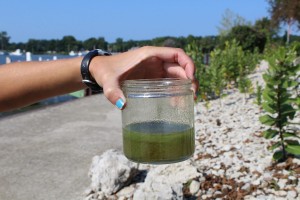SALEM, Ohio — A rainy June that saw more than 10 inches of rain in some counties will likely lead to a much more severe harmful algae bloom on Lake Erie than experts originally thought.
During a July 9 algal bloom forecast, Rick Stumpf, a lead oceanographer with the National Oceanic and Atmospheric Administration, said near-record rainfall has led to significant increases in phosphorus loading, which will likely mean more blooms later this summer.
“We’re looking at potentially the second worst bloom, after 2011. Worse than 2013,” he said.
The bloom is forecast on a scale of zero-10, with 10 being most severe. This year’s bloom is now forecast at 8.7, with the potential it will be as low as 8.1, and as high as 9.5.
Significant discharge
Laura Johnson, a research scientist with Heidelberg University, said water tests have documented a “very big discharge” in total and dissolved phosphorus entering the lake, which usually means a large bloom will follow.

At the end of May, Stumpf said the forecast was below 4, or a “moderately low severity bloom.” But that all changed as the rains fell, and continued to fall.
Farmers, researchers, state and federal governments have pumped millions of dollars into new conservation practices designed to reduce runoff — but severe weather continues to be a challenge.
Fighting weather
Officials with the Ohio Corn and Wheat Growers Association and the Ohio Soybean Council said they are concerned about the forecast and plan to continue good conservation practices. But no matter what they do — nature is often unpredictable.
“While these actions will make a difference, one variable that farmers cannot control is rainfall,” they said, in a released statement. “Unfortunately Ohio has experienced record rainfall this year – making a difficult and complicated problem even more so.”
The rain has led to more field runoff — but also additional sewage overflow and municipal runoff — which also contribute to the problem.
In August of last year, the issue received international attention when an excessive amount of the toxin entered one of the Toledo water treatment plants, resulting in a drinking water ban that lasted two days.
Some of the blame was undoubtedly on the algae — which had been blown into the Maumee Bay by strong winds. But there was also concern that the treatment plant could have been better prepared.
Being prepared
Stumpf said with all of the warnings, cities this year are ready.
“Water treatment plants are ready,” he said. “They are prepared with the chemicals that they need (to treat toxins). There will be no surprises.”
But even if the bloom becomes severe — which is expected, Stumpf said people can still safely enjoy the lake.
“There is a huge amount of lake that will be free of this stuff,” he said. “Activities can still go on.”
The nutrient issue continues to be a priority for Ohio farmers, state, national, and also international governments.
A June 30 announcement by the U.S. and Canada calls for a 40 percent reduction in phosphorus loading, which environmental experts from both countries hope to achieve by February of 2016. This would be a reduction of about 6,000 tons of phosphorus.
Both countries are working together on the issue, as part of the 2012 Great Lakes Water Quality Agreement.
The algae forecast was part of a larger webinar, broadcast from Ohio State University’s Stone Lab, on the islands of Lake Erie.
More information:
• To learn more about harmful algae, and public advisories, visit the Ohio EPA algae website.
• To learn more about the forecast in this article, visit the Ohio Sea Grant’s page here.
• For more about Stone Lab, visit them here.











